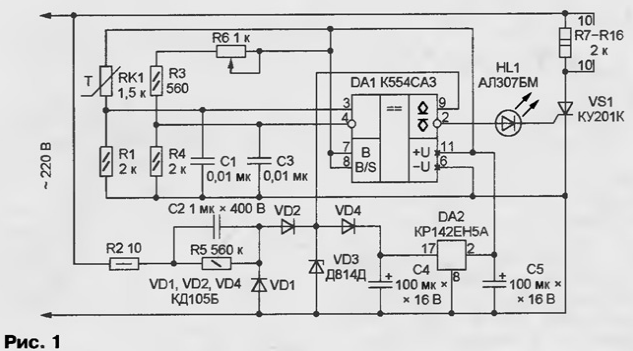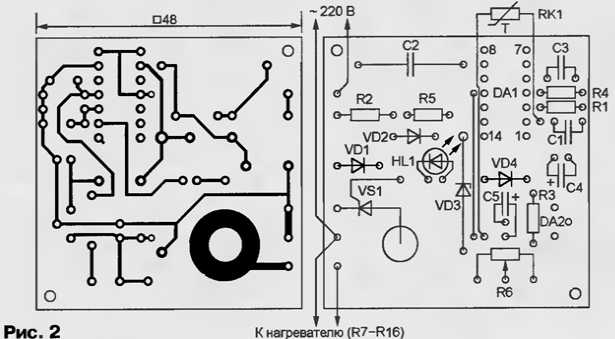Excretion Chicks in the incubator is a laborious process that takes a lot of time and require constant temperature control. The last responsibility takes on we also offer thermostat. The author talks about simple design incubator, gives advice on its use.
The thermostat, the circuit of which is shown in Fig. 1, is designed to small incubator and keeps it in a predetermined in the range of 20...50°C temperature. Sensor is a thermistor RK1, together with resistors R1, R3, R4, R6 forms a measuring bridge. Balance the bridge at a given temperature get a variable resistor R6. Capacitors C1 and C3 - suppression.

If the temperature is above the setpoint, the polarity of the voltage unbalance of the bridge at the entrance comparator DA1 is such that the output transistor of the last closed, or the event is open To the DA1 pin 9 (the collector of the output transistor) is fed from the output of half-wave rectifier diodes VD1 and VD2 pulsating voltage. The amplitude of the pulses is limited by the Zener diode VD3. At temperatures below given the pulses from the DA1 pin 2 (emitter of the output transistor) is transmitted to the control electrode of SCR VS1, opening it in the positive half-cycles the mains voltage. Connected in parallel resistors R7-R16 are a heating element.
Chain VD4C4 converts pulsating DC voltage. After the stabilizer DA2 they nourish the measuring bridge and a comparator.
The printed circuit Board of the thermostat and the arrangement of parts therein shown in Fig. 2.

The following replacement items: comparator CSS (DA1) - with SS given the differences in pin assignment, integral stabilizer CREA (DA2) - for any other output voltage 5...6 V and a load current of at least 50 mA, SCR CUC (VS1) on COOL, COK-KUN, diodes CD (VD1, VD2, VD4) - on any silicon with the allowable current of 150... 300 mA, the Zener diode DD (VD3) - on DG. As RK1 applied to the thermistor CT1-17, its denomination (resistance at room temperature) can reach 4.7 Ohm, just need to the number of times corresponding to increase and the values of the resistors of the measuring bridge. Variable resistor R6 - SDR-4A. Oxide capacitors - K50-35 or similar. The capacitor C2 - K73-17 at a voltage of At least 400
The incubator is a foam box dimensions 600x600x300 In mm. her bottom drilled hole diameter 6...10 mm for air access and an extruded groove in which to maintain the necessary humidity pour water 43°C (when pouring). Inside install a metal grate for laying eggs, place the thermistor RK1 and the heating element of the resistors MLT-2 (R7-R16). To reduce the inertia of the heater by collecting it from resistors MLT-0,5. The number and denominations choose tcim to total the resistance remains the same and not exceeded the power receivemy one Heater resistor and can serve as a standard bulb filament or heater power 20...30 watts voltage 110...127V.
In the room where the incubator, you need a constant flow of fresh air, and the temperature should not go beyond 20...25 °C. the incubator is not should fall direct sunlight. A few hours before laying eggs should to turn on the thermostat, with the variable resistor R6 is set in the incubator temperature of 37.5 °C and make sure it was stable. For control in designated hole in the lid of the incubator insert alcohol thermometer. The duration of incubation of eggs of different birds are shown in table.

If the Chicks of the first brood will hatch a day early, in further install the outdoor air temperature is 0.5 °C less than specified above, if a day later, on the same more.
Eggs should be fresh, blogspotanime, age not more than 15 days and air chamber in the blunt end. Wash and SuperCool eggs should not be. In the incubator they must be loose, sharp blunt end below. Need three times a day to turn the eggs, ending this procedure only three days before expected brood. For flipping eggs have to open the incubator then the temperature regime in him is restored within one or two hours. To accelerate this process by adjusting the variable resistor R6 should not be. Not long before hatching eggs are heated due to the heat therefore, the temperature in the incubator should be reduced by 0.5°C.
The same thermostat suitable for home greenhouses. To change interval supported temperatures, enough to pick up the value of the resistor R4 The power of the heater must correspond to the amount of greenhouses.
Author: S. Abramov, Orenburg






